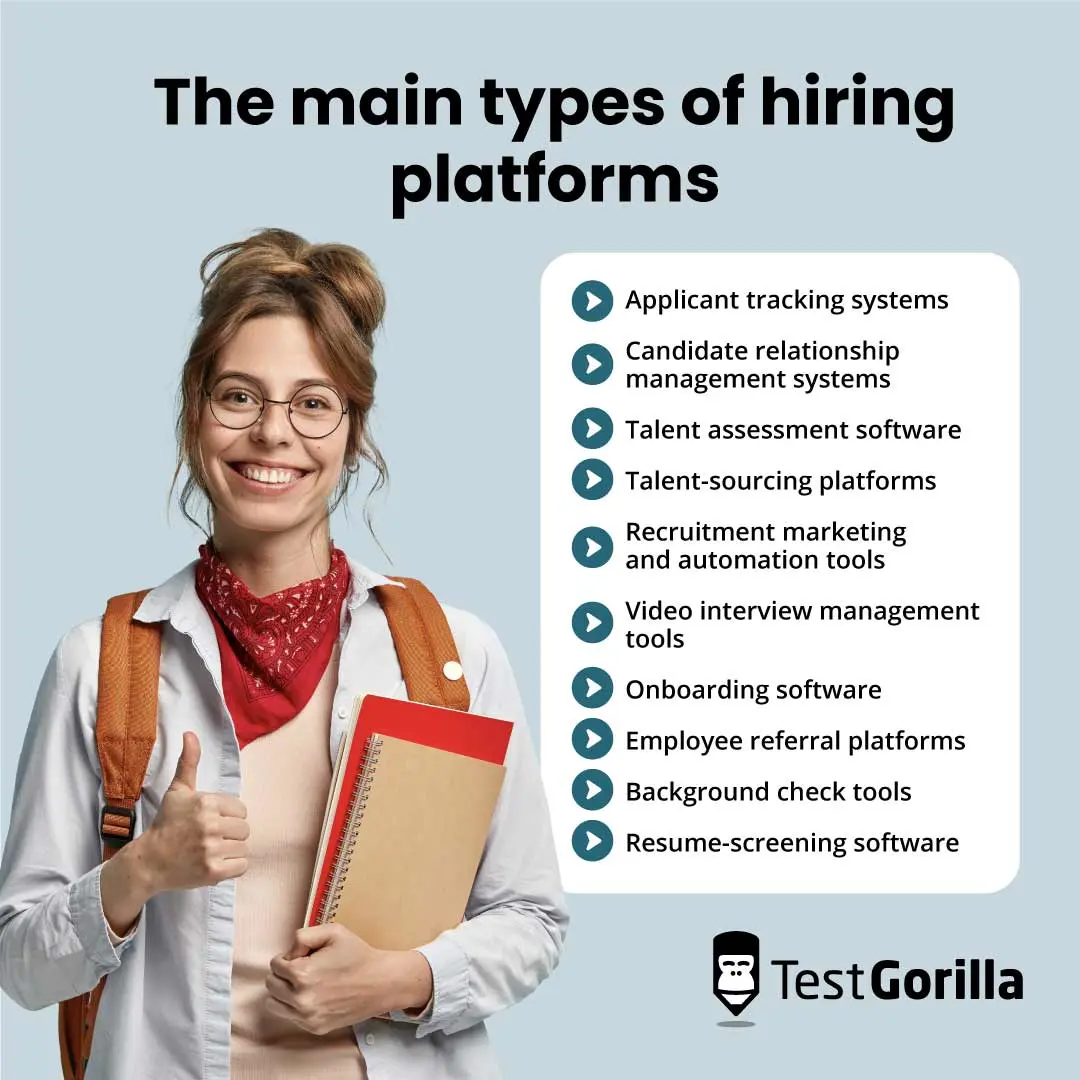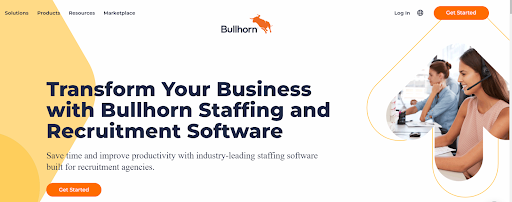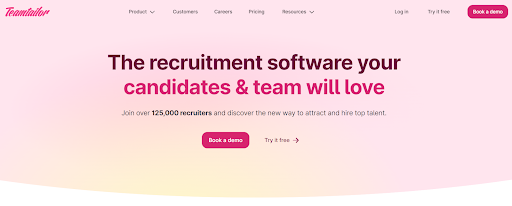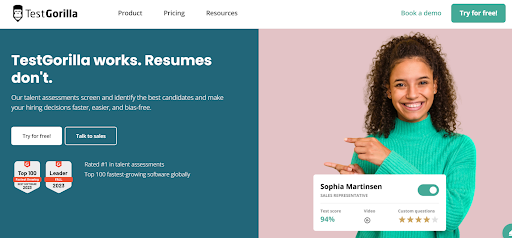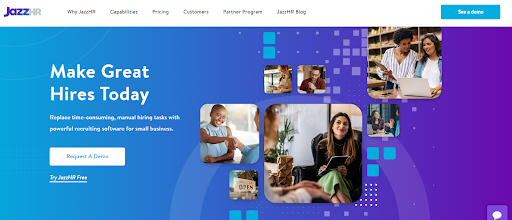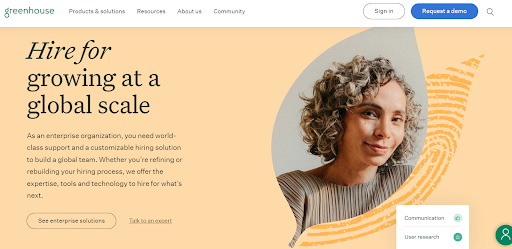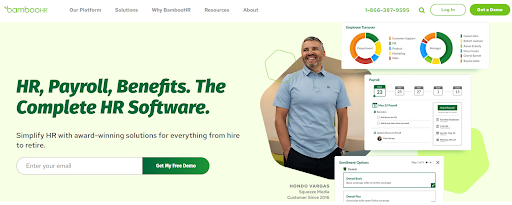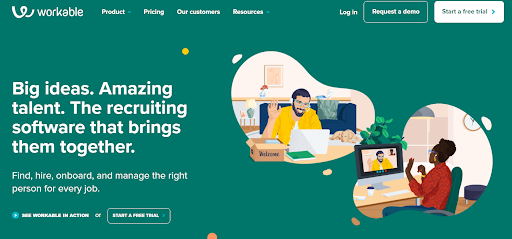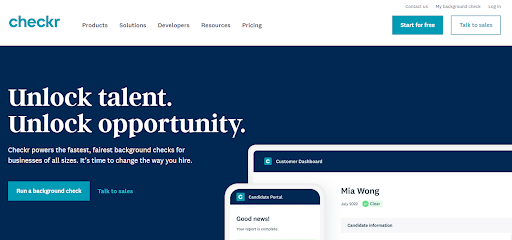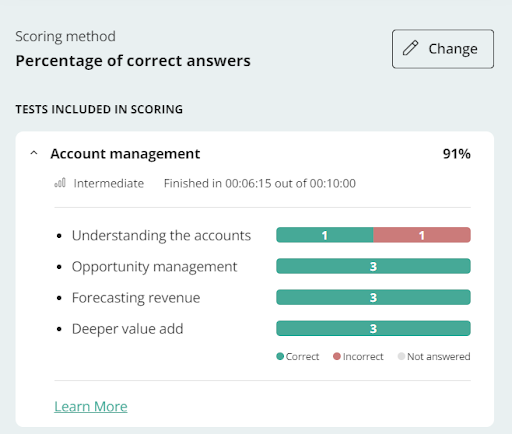Recruiting platforms: A guide for HR professionals looking for the most effective hiring platforms
As a recruiter, chances are you’re always on the lookout for new HR technology to optimize your processes and find the best talent.
Your candidates care, too. In fact, 54% of the newest generation of job seekers don’t even complete an application if the hiring process is outdated.[1]
Recruiting platforms keep your processes streamlined and modern, making the process easy for you and improving the candidate experience for your applicants.
But the world of hiring platforms is massive, and finding the right ones for your business can quickly get confusing.
Does your organization need talent assessment software to check leadership and people management skills? Or maybe it would benefit from a background check system?
Either way, you’re in the right place: This guide lays out the top recruitment platforms and who they’re best for, best practices for leveraging them, and real-life examples of them.
Table of contents
- What is a recruitment platform?
- 9 best recruiting platforms for HR teams
- Why are hiring platforms important?
- The benefits of recruiting platforms
- 5 best practices for the adoption of online recruitment platforms in HR departments
- 3 examples of companies succeeding with hiring platforms
- Leverage recruiting platforms to hire for skills
- Recruiting platforms FAQs
What is a recruitment platform?
A recruitment platform is software that facilitates the hiring process by helping recruiters launch job ads, search for job applicants, screen potential candidates, or track applications and interviews.
Recruiting platforms are essential in the modern age. Open roles are getting more applicants, which means recruiters need more help managing them.
It’s also important to create a smooth candidate experience during a skills shortage. With this outlook, outdated hiring processes simply won’t do anymore.
An outdated hiring process might look like this:
Relying strictly on candidates’ resumes and education
Communicating too slowly or infrequently
Using processes that aren’t mobile-app friendly
Mandating in-person interviews
Limiting the talent pool to local candidates
Online recruitment platforms facilitate your company’s move away from these inefficient processes and toward more modern practices.
The best online hiring platforms also help you address HR technology trends, like taking advantage of the machine learning trend by leveraging AI powered hiring platforms.
The main types of hiring platforms
Let’s quickly cover the 10 most popular types of HR recruiting platforms:
Recruitment platforms | Quick description |
1. Applicant tracking systems (ATS) | Enables you to track candidates throughout the recruitment process |
2. Candidate relationship management systems (CRM) | Helps manage and nurture candidate relationships |
3. Talent assessment software | Gauges candidates’ skills and competencies by evaluating them through online tests |
4. Talent-sourcing platforms | Finds potential employees by proactively searching through candidate data and posting on job boards |
5. Recruitment marketing and automation tools | Improves marketing initiatives like launching recruitment emails and capturing contact information |
6. Video interview management tools | Enables you to easily conduct video interviews from a private platform |
7. Onboarding software | Eases the onboarding process with document management and accessible training information |
8. Employee referral platforms | Encourages and simplifies employee referrals with a centralized system |
9. Background check tools | Sends background check requests and review reports |
10. Resume-screening software | Scans resumes for preferred experience, words, or phrases |
It’s important to note that these platforms are not usually mutually exclusive. For example, it’s common for applicant tracking systems to have CRM functionality.
9 best recruiting platforms for HR teams
Let’s dive right into our list of the best hiring platforms for talent acquisition, including picks for an all-in-one platform and the best talent assessment software.
Afterward, we take a step back and examine the importance and benefits of hiring software. Feel free to jump ahead if you want to check those out now.
Factors we considered
We considered the following points as we built our list of the best recruiting platforms:
Integration with other recruitment tools: Integration improves productivity and gives you a seamless experience in your tech stack
Automation: HR automation takes care of tedious tasks and enables you to focus on important responsibilities
Customization: Personalizing your software helps you create a more professional experience
Ease of use: Accessibility makes recruiting software simpler to use and eases the learning curve
Insight into the process: Analytics give you visibility into your recruitment process, enabling you to enhance your strategy
The top recruitment platforms: A summary
Tool | How it helps |
1. Bullhorn | An all-in-one ATS and CRM system |
2. Teamtailor | Hiring software that prioritizes the candidate experience |
3. TestGorilla | Recruiting software that gauges real candidate skills through talent assessments |
4. JazzHR | Talent sourcing software that features one-click job posting across multiple channels |
5. Greenhouse | Recruitment software that boasts high-volume features for large companies |
6. VidCruiter | A remote hiring platform that facilitates live and asynchronous video interviews |
7. BambooHR | HR software that streamlines onboarding |
8. Workable | A system that simplifies and gamifies employee referrals |
9. Checkr | Background check software that reduces bias and improves efficiency |
1. Bullhorn: Best all-in-one platform
Bullhorn is an ATS and CRM that also has talent sourcing and job posting features. This tool is a powerful “one-stop shop” that gives you the functionality of several recruiting software platforms.
This software provides solid AI and automation features, helping you eliminate tedious tasks and build a standardized hiring process. Automated communication, such as its HR chatbot, also boosts the candidate and employee experience.
To further streamline your recruitment, it also integrates with TestGorilla, so you can view talent assessment results right from Bullhorn.
Pros | Cons |
- Customizable - Makes managing candidates easy - Excellent automation - Easy sourcing and job posting | - Complex to learn to use - Some users say the loading times are slow |
G2 Rating: 4.0 out of 5
Pricing as of December 2023: Quote available on request
Honorable mentions for all-in-one platforms
We also recommend checking out these two tools:
Crelate, an easy-to-use combination ATS with CRM capabilities, built specifically for recruiting agencies
Ceipal, an AI-driven ATS and CRM that helps source passive candidates and easily integrates with more than 50 job boards
2. Teamtailor: Best for candidate experience
Teamtailor is an applicant tracking system with deep customization, a drag-and-drop interface, automatic GDPR compliance, and simple integration with TestGorilla.
It boasts many features that enable you to simply improve the candidate experience, such as sending automated candidate surveys and enabling candidates to log into the system without an account.
This is one of the best hiring platforms for making the hiring process comfortable for your candidates and enhancing your employer branding.
Pros | Cons |
- Ease of use - Great customer support - Excellent user interface - Integration with other tools | - Some users complain that the analytics need more detail - Some users say that candidate data and metrics should be easier to export |
G2 Rating: 4.7 out of 5
Pricing as of December 2023: Quote available on request
Honorable mentions in candidate experience
These two tools are also worth checking out:
Jobvite, a cloud-based system that offers great candidate communication and reduces tedious tasks so recruiters can focus on candidates
SmartRecruiters, hiring software that offers a great candidate experience through a simplified UX and automated scheduling
3. TestGorilla: Best for talent assessments
TestGorilla is a talent assessment platform with more than 300 skills tests to gauge candidates’ skills and competencies.
This talent assessment software allows you to build custom skills assessments with up to five tests in each one. You can build highly specific, specialized assessments for your job openings.
TestGorilla also goes beyond technical skills, helping you assess crucial soft skills and personality traits like motivation and cultural alignment.
If you’d like to know more about TestGorilla, read our deep dive comparison on the best online test platforms for recruiters.
Pros | Cons |
- Easily searchable candidate database - Custom assessments - More than 300 skills tests - Easy to customize assessments | - Some users would like more flexible pricing options, such as a monthly plan instead of a yearly plan - Currently no live video interviewing tools |
G2 Rating: 4.5 out of 5
Pricing as of December 2023:
Base account: Free
Starter package: From $75 a month
Pro package: From $115 a month
Honorable mentions in talent assessments
Also check out these two tools:
HackerRank, a talent assessment system for programmers with realistic scenario tests
Codility, a tech hiring platform with an emphasis on learning and development
4. JazzHR: Best for talent sourcing
JazzHR is recruiting software that facilitates quick and easy job posting on free and paid job boards.
Gone are the days of only posting open roles on your career page. This platform enables mass job ad posting, where one click publishes your job to multiple job sites, like Indeed and LinkedIn, and social media channels.
In addition to social recruiting, it also supports other popular talent-sourcing methods, such as facilitating employee referral programs.
JazzHR also makes it simple to manage collaborative hiring with multiple recruiters. Features like calendar and schedule sharing and quick candidate information sharing make team collaboration easy.
Further, it integrates with TestGorilla so you can view assessment results without leaving JazzHR.
Pros | Cons |
- Also contains ATS features - Quick and easy to set up job posts - Watchlist you can add top candidates to for future hiring - Quick referrals | - Lack of clear reporting - Some users would like more customization features |
G2 Rating: 4.4 out of 5
Pricing as of December 2023:
Hero package: $49 per month
Plus package: $239 per month
Pro package: $359 per month
Honorable mentions in talent sourcing
We also recommend checking out these two tools:
SeekOut, a talent sourcing tool with highly rated ease of use
Entelo, a talent sourcing tool that streamlines communication and follow-ups
5. Greenhouse: Best for midsize to large companies
Greenhouse is a powerful ATS with many features, including capturing contact information, personalizing and scaling outreach, and high-powered automation.
This software boasts recruitment CRM features, too, offering deep insights into the candidate journey and easy management of candidate relationships.
Greenhouse is best for large companies, like The New York Times and Hubspot, two of its customers. Due to how extensive its features are, many of them aren’t usable by small recruiting teams or startups.
Pros | Cons |
- Robust reporting features - Excellent integration - Great automation - Detailed onboarding options | - Complicated interface - Many features aren’t usable for small teams |
G2 Rating: 4.4 out of 5
Pricing as of December 2023: Quote available on request
Honorable mentions for large companies
Here are two more platforms to check out:
Lever, an excellent combination ATS and CRM for large companies
JobDiva, an ATS that helps large staffing agencies handle high-volume hiring
6. VidCruiter: Best for remote hiring
Vidcruiter is a video interviewing platform that helps remote companies optimize their interviewing process.
This remote working technology enables asynchronous job interviews, which is perfect for work-from-home jobs or distributed teams in different time zones. One-way interviews are also great for hectic schedules.
VidCruiter keeps a secure record of each interview for you to review and includes an on-the-spot rating system so you can assess a candidate’s performance in real-time.
Pros | Cons |
- User friendly - Easy to navigate - Excellent customer support | - Some users would like more white-labeling options - Some users would like more integrations |
G2 Rating: 4.8 out of 5
Pricing as of December 2023: Quote available on request
Honorable mentions in remote hiring
The two tools are also great for remote hiring:
HireVue, a remote video interview tool that leverages AI in HR features, such as a conversational AI that communicates with candidates via text
Spark Hire, a remote video interview tool with a quick Google Chrome extension
7. BambooHR: Best for onboarding
BambooHR has a host of HR functionality, but many companies primarily use it for onboarding due to its strong onboarding capabilities.
It boasts simple onboarding from the admin and employee perspective, including employee profile creation, policy creation and application, and easy-to-build signature request forms.
Onboarding is the first impression that people get of your company, so employee onboarding software should make the process smooth and comfortable.
Pros | Cons |
- Streamlined onboarding for admins and employees - Easily create policies and distribute them to employees - Build and share contracts and forms - Personalized onboarding packages depending on role and department | - No international support for leave policies, holidays, and payroll - Quite expensive |
G2 Rating: 4.5 out of 5
Pricing as of December 2023:
Essentials tier: $5.25 per month
Advantage tier: $8.75 per month
Honorable mentions in onboarding
We also recommend checking out these two tools:
ClearCompany, which helps recruiters through every step of the employee journey, including onboarding
WorkBright, a platform that ensures secure, inclusive onboarding
8. Workable: Best for employee referrals
Workable is one of the best recruiting platforms for employee referrals, making it easy and fun to refer professionals to your company.
The platform makes it easy for workers to refer colleagues by providing a name and a link to an online candidate profile. It also makes it just as simple for you to share open positions with your network.
It leverages gamification in HR features to encourage employee participation, offering referral tracking, social sharing, and performance rewards.
Pros | Cons |
- Easy to use - Great customer service - Keeps employees informed about internal opportunities - Keeps employees informed about their referred candidates | - Some users mention reporting errors - Few customization options |
G2 Rating: 4.6 out of 5
Pricing as of December 2023: Starts at $149 per month
Honorable mentions in employee referrals
Also check out these two tools:
Hireology, a software that enables you to create a customized employee referral program
Boon, hiring software that makes it simple for employees to refer colleagues in less than 30 seconds
9. Checkr: Best for background checks
Checkr aims to empower businesses by conducting fast, fair background checks on potential hires.
It helps save time, reduce human error, and minimize bias by conducting background checks powered by artificial intelligence.
This boosts the candidate experience and improves the overall efficiency of the hiring process.
Pros | Cons |
- Fast results - Mobile-friendly - Great customization - User friendly | - Some international candidates can have slow checks - Not enough notifications when checks are complete |
G2 Rating: 4.5 out of 5
Pricing as of December 2023:
Basic+: $29.99/check
Essential: $54.99/check
Professional: $79.99/check
Honorable mentions in background checks
We also recommend checking out these two tools:
HireRight, background check software that’s suitable for all company sizes
VICTIG Background Checks, background check software with fast turnaround time and award-winning customer service
Why are hiring platforms important?
Each job ad is getting more applicants, but at the same time, job seekers expect a better candidate experience.
It’s a difficult balance.
Recruiting software platforms enable you to maintain that balance. They help promote better communication through automated message templates, ensure more transparency, and encourage a fair hiring process.
All of this translates to less candidate ghosting, too. Candidates are likely to drop out of your recruitment funnel when the process is slow or outdated.
The best recruiting tools also leverage HR analytics software so you can use data from previous efforts to build better future hiring strategies.
Using the right platforms for hiring also helps you open your talent pool and hire better candidates.
Modern software enables small companies to reach beyond their borders and find candidates from other regions or even countries.
If you’re using platforms that reduce hiring bias, such as talent assessments, you can open your talent pool even further by getting rid of unnecessary requirements like college degrees.
Then, once your talent pool is wide open, you can use recruiting software platforms to find the best applicants.
For example, with talent sourcing software and talent assessments, you can find excellent candidates and objectively gauge their skills.
The benefits of recruiting platforms
Here’s a quick look at the main benefits of using recruiting platforms:
Advantage | Details |
1. Improves candidate engagement | Companies that use automated software have reduced candidate drop-off, as well as more effective hiring and quicker interview scheduling |
2. Increases hiring speed and efficiency | Our State of Skills-Based Hiring report found 82% of organizations using skills-based hiring methods like talent assessments reduced their time-to-hire |
3. Matches employees to roles and opportunities | The same study found that 89% of employers believe skills-based hiring methods like talent assessments are more predictive of on-job success than resumes |
4. Improved candidate experience | One report found the top ways to improve the candidate experience are tossing away resumes, communicating with candidates throughout the process, and promoting transparency |
5. Completes tedious administrative tasks | Searching for, reaching out to, vetting, and interviewing candidates are some of the most time-consuming tasks in HR |
5 best practices for the adoption of online recruitment platforms in HR departments
Recruiting software platforms are powerful, but you can’t just purchase them and call it a day. You need thought-out strategies to implement, leverage, and maintain them.
Here’s a look at our top tactics for adopting recruitment platforms.
Strategies for adopting hiring platforms: A summary
Strategies | Description |
1. Build a complete tech stack that covers your entire process | Adopt tools that assist your hiring process from assessing recruitment needs to onboarding |
2. Build external talent pools and nurture them with automation | Engage and attract a large pool of qualified talent with hiring platforms, building better relationships |
3. Consider internal candidates in your recruiting efforts | Facilitate internal mobility with an internal talent marketplace and talent assessments |
4. Use talent assessments to inform multiple steps of the hiring process | Leverage talent assessments in multiple ways, such as conducting a skills gap analysis |
5. Never lose the human touch | Use human skills for sensitive matters, like conducting interviews and making final hiring decisions |
1. Build a complete tech stack that covers your entire process
There are many different types of hiring platforms available, so it’s possible and beneficial to leverage them from start to finish.
Your tech stack can cover the entire hiring cycle:
Assessing hiring needs
Building job descriptions
Candidate sourcing
Job ad posting
Attracting applicants
Screening candidate quality
Interviewing
Onboarding
In this way, you eliminate any outdated bottlenecks in the middle of the process, such as manual interview scheduling.
With the right strategy, a few key tools can support the entire hiring process. For example:
TestGorilla assesses hiring needs and informs your job descriptions
JazzHR sources candidates, posts job ads, and attracts applicants
TestGorilla screens candidates, and the results show up in JazzHR due to the integration
JazzHR helps schedule interviews
The information you got from TestGorilla’s talent assessments helps inform onboarding, showing you the new hire’s preferred work style and learning ability
JazzHR automates onboarding paperwork
This not only keeps the entire workflow streamlined and modern, it also keeps it consistent.
2. Build external talent pools and nurture them with automation
Recruitment software makes it quick and easy to grab likely candidates and build great relationships with them. This increases your employer branding and helps when recruiting passive candidates.
Which hiring software does this? Quite a few, and here’s how to combine them to get the best effect:
Use talent sourcing software, like JazzHR, to build an excellent external talent pool
Use talent assessment software, like TestGorilla, to collect candidate information in a database for future hiring
Use candidate relationship management software, like Bullhorn, to nurture candidates, communicate with them, and carry them through the recruitment funnel
Recruitment automation software, like Bullhorn and TestGorilla, is particularly good at building a strong external talent pool.
When you automate answers to questions, interview invitations, and rejection letters, it lays a solid foundation for who you are as an employer. This reduces ghosting from applicants and attracts more top talent to your future hiring efforts.
3. Consider internal candidates in your recruiting efforts
An external talent pool is important, but never forget the talent that’s in your company.
Internal hires already know your company culture, and they’re more affordable. Further, the more you encourage internal mobility, the more your reputation for learning and development grows.
Many of the best hiring platforms include features that facilitate internal mobility. For example, you can use recruiting platforms to help build an internal talent marketplace.
Talent assessment software enables you to assess employees’ skills so you can create detailed employee profiles for your marketplace. This improves the accuracy of your marketplace’s employee-to-role match, streamlining your internal mobility.
4. Use talent assessments to inform multiple steps of the hiring process
Talent assessments are a strong tool that can be used to enhance multiple steps of the hiring process, from uncovering the right skills for job descriptions to hiring top talent.
Here are a few different stages of the employee journey where you can use talent assessments:
Gauging candidates’ skills during screening
Informing job interviews by giving you key talking points
Enhancing onboarding by showing a candidate’s areas of improvement and learning style before day one
Assisting skills gap analyses once the employee is hired
Here’s a quick example of an employee skills gap using TestGorilla
This Account Management test shows that the candidate is strong in most fields but needs improvement in understanding the accounts. This data helps you build targeted development plans.
This benefits your company overall, but it also does a great job of improving the employee experience. For more information on this subject, read our guide on employee experience software.
5. Never lose the human touch
Hiring software is essential nowadays. Automation, AI, and algorithms help us streamline recruitment and provide a great experience.
However, no matter how much we all adopt tech, it’s crucial to never lose the human touch.
Many processes thrive when done by hiring platforms, but HR professionals need to stay mindful of which tasks need their personal attention.
Tasks like reviewing job descriptions, making final hiring decisions, and conducting interviews can’t be fully trusted to tech – they’re too important.
These tasks require key skills that only humans have, such as empathy and critical thinking.
For example, some video interview tools scan a candidate and automatically approve or reject them based on whether their body language is “right.” This is harmful and could result in discrimination.
People from other countries, such as Japan, have their own perceptions of what “normal” body language is.
If you don’t strive to maintain the human touch throughout recruitment, it could deny candidates opportunities and let top talent slip through your fingers.
For more insights on this topic, read our article on how to automate recruitment wisely.
3 examples of companies succeeding with hiring platforms
Recruiting platforms help companies shortlist applicants, manage candidates, and hire better employees.
Thousands of organizations are using these programs to streamline their recruitment and provide a better experience for candidates and hiring managers.
Here are three companies seeing great success with hiring software.
Comfort Dental
Smart WFM
Dyninno
Comfort Dental
Comfort Dental, a family dental care company, needed a better, more streamlined way to source and hire candidates. Its current processes were too slow and weren’t producing quality hires.
This company adopted JazzHR.
This software was a great choice for Comfort Dental, integrating with many of its preexisting systems. But the biggest perk of choosing JazzHR was how it attracted and retained candidates.
This company leveraged the platform’s recruitment text messaging so it could contact candidates in real time and help them stay competitive.
Here are the results:
Reduced time-to-hire
Larger talent pool
Better qualified candidates
Stronger employer brand
Comfort Dental also saves money by “hibernating” its account between hiring efforts, which is beneficial for small businesses.
Smart WFM
Smart WFM, a human capital management consultancy, needed to optimize its onboarding – so it turned to BambooHR, our onboarding choice above.
This company’s previous process was outdated and filled with time-consuming tasks. Further, employees found it difficult to access crucial HR information.
BambooHR made it simpler to join the company and access HR services.
The centralized employee database makes it easy for employees and HR professionals to access records, training documents, certifications, company information, and employee pulse surveys.
This recruiting software has improved onboarding effectiveness and consistency.
“Onboarding is absolutely fantastic,” says Rob Scott, the chief operating officer, “Most employees have commended us and said, ‘Wow, Rob, that’s the most impressive onboarding exercise I’ve gone through in my entire career.’”
Dyninno
Dyninno – a group of companies that provides services in the travel, finance, entertainment, and technology sectors – needed a new way to hire.
This company wanted a skills-first approach, but resume screening software wasn’t an effective tool to find the skills it needed.
Pavel Bahu, the global human resources director, talked about the group’s skills-based approach:
“Honestly, a resume isn't our main focus because we're not hiring a piece of paper; we're hiring for skills.”
But without the right tools and a high volume of applicants, skills-based hiring is tough.
Dyninno adopted TestGorilla talent assessments to solve this issue and saw dramatic results. With talent assessments, the same hiring team was able to evaluate four times as many candidates at once, improving productivity by 400%.
Talent assessments also attract more candidates. Dyninno saw a 30% increase in conversion from job posts to screened applicants.
Leverage recruiting platforms to hire for skills
There are hundreds of handy recruiting platforms available, so it’s time to take a dive into HR software and find out what’s right for your company.
The best hiring platforms offer candidates an engaging, streamlined experience while also helping your hiring team be more comfortable and organized at work.
We recommend you grab one or two tools to start and slowly build from there.
To get started, check out our guide on building an HR tech stack as a way to organize everything you've learned in this post.
If you’d like to learn more about talent assessments, browse more than 300 in our test library.
Recruiting platforms FAQs
Here are some of the most frequently asked questions about recruitment platforms.
What is a recruitment platform?
A recruitment platform is a system that assists the hiring process in various ways, including posting job ads, sourcing candidates, and screening applicants.
Recruiting platforms can span a hiring process from start to finish.
What is the best platform to hire people?
A variety of platforms and career sites should be used to hire the best candidates. For example, using talent sourcing software to post on diversity recruiting platforms helps you source more diverse candidates, widening your talent pool.
What is a talent assessment platform?
A talent assessment platform is software that enables hiring managers to accurately evaluate candidates’ skills and competencies through skills tests.
These assessments enable recruiters to use real data to make decisions, improving the quality of hire and reducing hiring bias.
How do I choose recruitment software?
You must consider your business goals, hiring needs, current processes, and the size of your company. All of these points factor into your decision.
Source
“The 2019 Yello Recruiting Study: Meet Generation Z”. (2019). Yello. Retrieved November 14, 2022. https://yello.co/resource/white-paper/generation-z-recruiting-study/
Related posts
Hire the best candidates with TestGorilla
Create pre-employment assessments in minutes to screen candidates, save time, and hire the best talent.
Latest posts
The best advice in pre-employment testing, in your inbox.
No spam. Unsubscribe at any time.

Hire the best. No bias. No stress.
Our screening tests identify the best candidates and make your hiring decisions faster, easier, and bias-free.
Free resources
This checklist covers key features you should look for when choosing a skills testing platform
This resource will help you develop an onboarding checklist for new hires.
How to assess your candidates' attention to detail.
Learn how to get human resources certified through HRCI or SHRM.
Learn how you can improve the level of talent at your company.
Learn how CapitalT reduced hiring bias with online skills assessments.
Learn how to make the resume process more efficient and more effective.
Improve your hiring strategy with these 7 critical recruitment metrics.
Learn how Sukhi decreased time spent reviewing resumes by 83%!
Hire more efficiently with these hacks that 99% of recruiters aren't using.
Make a business case for diversity and inclusion initiatives with this data.

